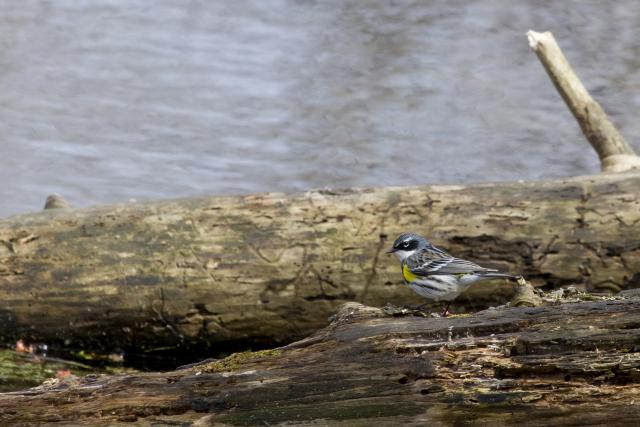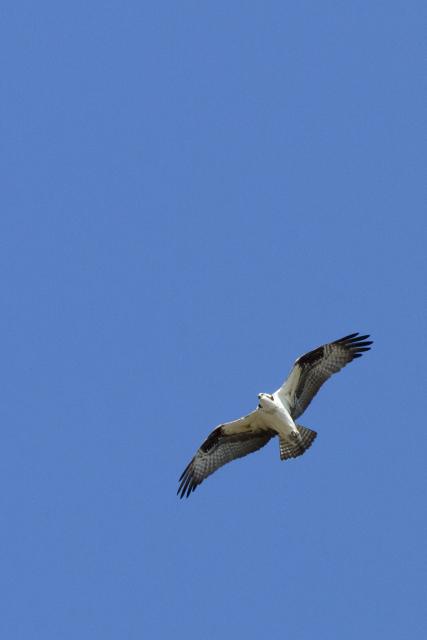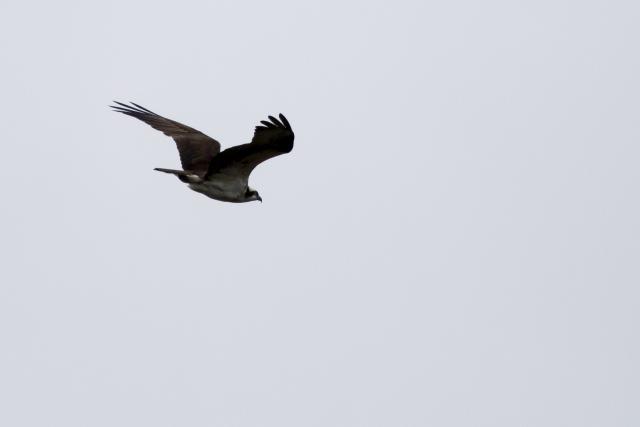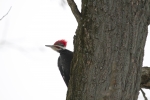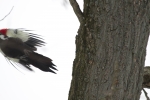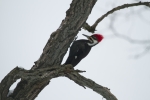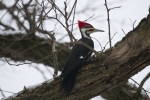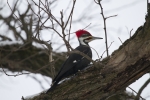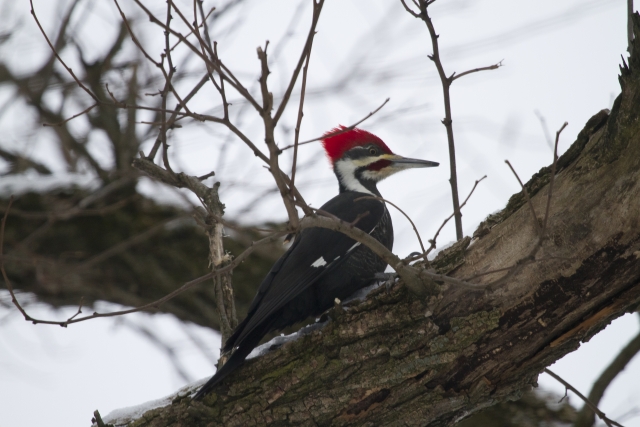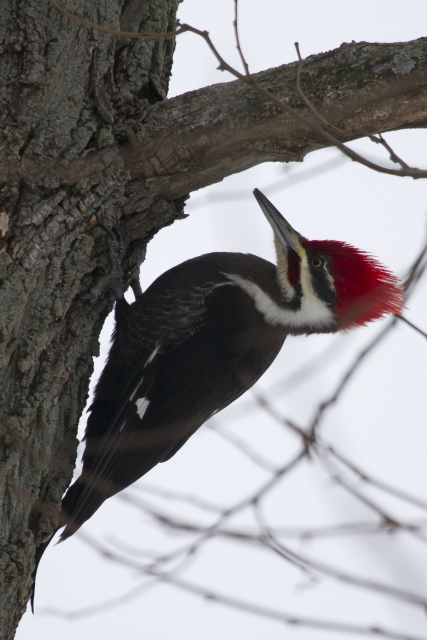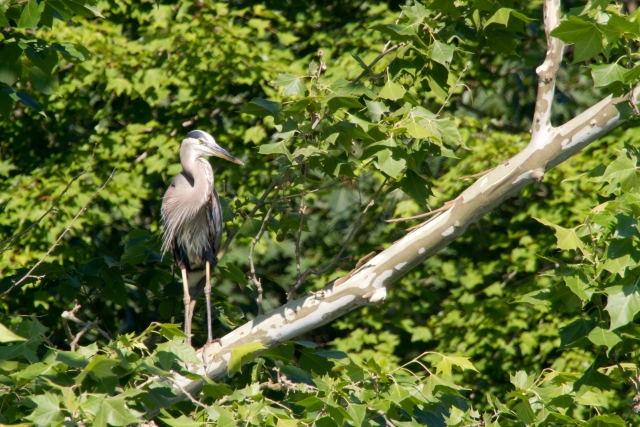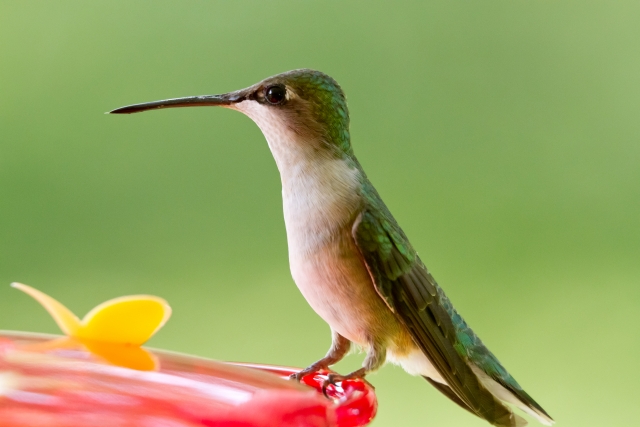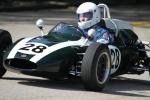birds
More Backyard Birds
ktuli — Mon, 04/27/2015 - 19:15
Well, today's posts are uncropped, but as you can see I did have some challenges with getting sharp images with some of the birds. The Ruby-crowned Kinglet was in amongst thin branches, so getting auto-focus to lock onto the bird and not a stray branch was difficult. With the Palm Warbler, the setting sun's light was getting so soft that the shutter speed got slow enough that movement blur became an issue. But continuing to practice with more "common" birds like the Robin and Chipping Sparrow got decent results even if they're not flashy birds...
 Ruby-crowned Kinglet Regulus calendula |
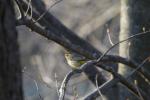 Palm Warbler Setophaga palmarum |
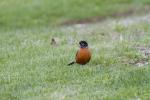 American Robin Turdus migratorius |
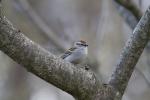 Chipping Sparrow Spizella passerina |
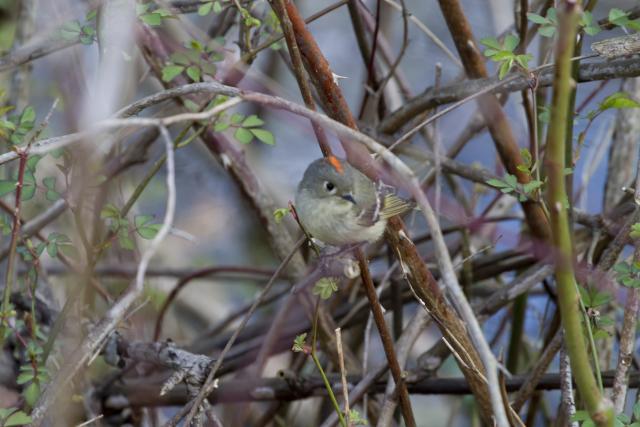 |
|||
Hopefully I'll get a chance to get out and look for some more birds this evening.
- Bill
More Cropped Osprey and Warblers
ktuli — Sun, 04/26/2015 - 20:20
Ok - so still working on bird photography, and still having to do some heavy cropping, but the results seem to be pretty decent...
First up is a Yellow-rumped Warbler (Setophaga coronata):
Technical Data Canon EOS 7D, Canon EF 100-400mm f/4.5-5.6L IS USM (borrowed) at 400mm, 1/320th sec at f/8. ISO 400. RAW processing and cropped in Adobe Camera Raw.
And the osprey has been making regular visits:
Technical Data Canon EOS 7D, Canon EF 100-400mm f/4.5-5.6L IS USM (borrowed) at 400mm, 1/1250th sec at f/8. ISO 640. RAW processing and cropped in Adobe Camera Raw.
Stay tuned.
- Bill
Heavy Cropping for Two Unusual Visitors
ktuli — Thu, 04/23/2015 - 17:51
OK - I normally try to avoid cropping at all with my wildlife photography, but that is usually hard to do. However, I rarely like to crop as heavily as I had two with these two images, but the subject material really made it worth-while.
Technical Data: Canon EOS 7D, Canon EF 100-400mm f/4.5-5.6L IS USM (borrowed) at 390mm, 1/3200th sec at f/5.6. ISO 800. RAW processing and cropped in Adobe Camera Raw.
That is an osprey. I actually didn't even upload a copy of the uncropped version, but suffice to say that you could pretty much only make out that it was a bird in that version. However, I am impressed with the results I got here as you can even make out the eye and some individual feathers in the full-size version
The next bird is much much smaller, but I was also way closer to it. But it still needed a heavy dose of cropping (mouseover the image for the original). This one we believe is a Palm Warbler...
Technical Data: Canon EOS 7D, Canon EF 100-400mm f/4.5-5.6L IS USM (borrowed) at 390mm, 1/320th sec at f/8. ISO 1250. Canon Speedlight 580EX II flash in auto mode with -1 EC plus Better Beamer. RAW processing and cropped in Adobe Camera Raw.
Thanks for stopping by.
- Bill
Bufflehead Crops
ktuli — Tue, 03/31/2015 - 19:57
Ok - as promised, I cropped a couple of the shots from my set with the bufflehead. As a rule, I generally try to crop as little as possible, but in this case it definitely does help to bring out some of the detail in the bird - especially the iridescence in its seemingly black feathers on its head.
This first one I shared yesterday...
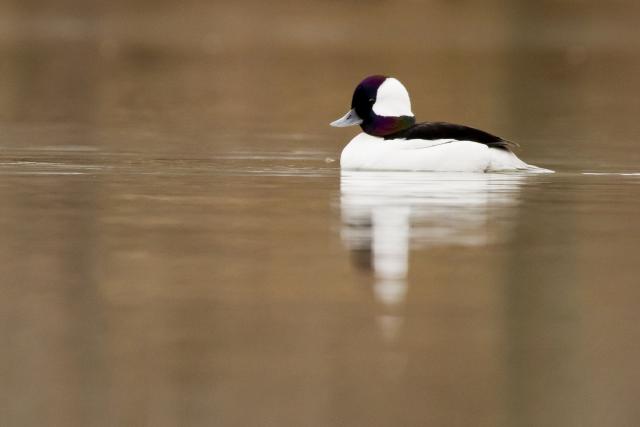 |
||
 |
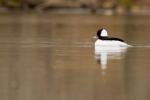 |
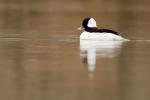 |
Technical Data: Canon EOS 7D, Canon EF 100-400mm f/4.5-5.6L IS USM (borrowed) at 400mm, 1/400th sec at f/8. ISO 800. RAW processing and cropped in Adobe Camera Raw.
As you can see, the exposure on these birds is tough with the bright pure white right next to dark jet black. Also, that first image has just hints of the iridescence showing up in the head feathers (see the slight purple hints at the top and bottom of the head?). This next one, however, shows it much more prominent!
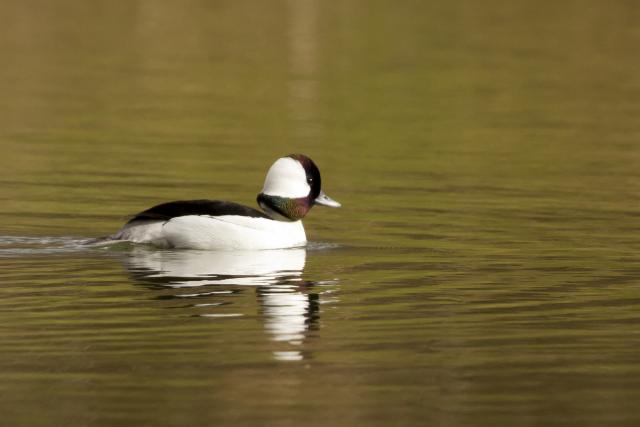 |
||
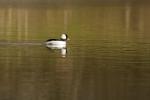 |
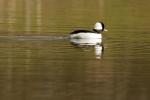 |
 |
Can you see that awesome purple and green iridescence showing through now? That isn't a trick of the camera or any kind of photoshopping... that is definitely how it was in person. Fleeting to see, but quite beautiful.
I also played around with trying different compositions with the crops - I go back and forth whether I like those decisions, but the increased size of the bird in the frame is definitely a nice benefit. For web viewing or possibly small prints, this kind of cropping is OK, but I still strive to get the shot just as I want it in the camera.
I tried to head out and see if I could get some photos of the hooded merganser that was on this pond yesterday, but the little bugger flew off before I could even get off the porch! I'll keep trying to get photos of these lovely migrating visitors, so stay tuned!
- Bill
Semi-Cooperative Bufflehead
ktuli — Mon, 03/30/2015 - 20:37
So things are steadily moving towards spring (even though we did have more snow on the ground this morning) and we're starting to get our annual migrating visitors on the pond. One new visitor we've never seen on our pond before is a small black and white duck called a Bufflehead. While not the showiest of ducks, it made up for that by being at least semi-cooperative.
Most of the other ducks that visit during their migration as extremely skittish and fly off with any attempt to approach the pond. This little guy on the other hand didn't fly off, but he also maintained a very healthy distance. As you can see in the first shot, I just couldn't get close for any kind of close-up shot. He tended to maintain about a 200 foot distance (as you can see in the left most photo below) no matter how I tried to position myself.
So after about an hour I decided to try something to get him to move in a little closer. I texted Anya who was in the house and asked her to approach the pond from the other side. That worked perfectly, and the bufflehead split the difference between us and moved a bit closer so I could get at least slightly better photos...
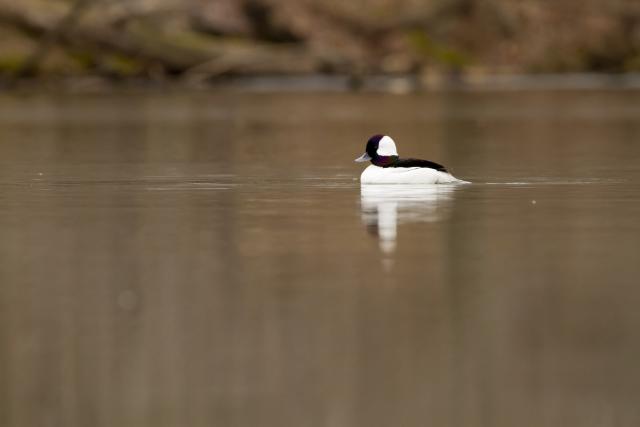 |
||||
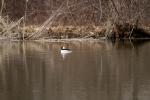 |
 |
 |
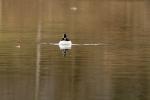 |
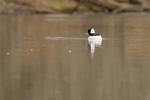 |
Technical Data: Canon EOS 7D, Canon EF 100-400mm f/4.5-5.6L IS USM (borrowed) at 400mm, Various exposures. RAW processing in Adobe Camera Raw.
These are all uncropped images, and I notice that they don't show off the nice iridescence that is the Bufflehead's one bit of flashiness. I'll try to remember to crop a few tonight for a bit closer of a look at that.
- Bill
More Pileated Woodpecker
ktuli — Mon, 01/26/2015 - 20:00
Pileated Woodpecker
ktuli — Sat, 01/24/2015 - 09:02
One good thing about winter is that with the leaves off the trees, it is easier to see birds. We've been seeing this Pileated Woodpecker come in closer and closer to the house recently, and this time I managed to get a couple decent shots...
Technical Data: Canon EOS 7D, Canon EF 100-400mm f/4.5-5.6L IS USM (borrowed) at 400mm, 1/800th sec at f/5.6. ISO 640. RAW processing and cropped in Adobe Camera Raw.
- Bill
Snow Bird
ktuli — Mon, 01/12/2015 - 18:15
Anya found this cool little imprint in the snow underneath one of her bird feeders.
Technical Data: Canon EOS 7D, Canon EF 100mm f/2.8L Macro IS USM, 1/1600th sec at f/8. ISO 640. RAW processing in Adobe Camera Raw.
With the popularity of The Hunger Games these days, she said it reminded her of the mocking jay logo. Personally, it just reminded me that my fingers were getting cold and I should go back inside!
- Bill
Poll: Hummingbird - Flash or No Flash?
ktuli — Wed, 07/23/2014 - 19:29
So here's a couple more shots of one of our hummingbirds (actually, it might be two different ones, but I'm not sure) taken with two different methods. Each one seems to have its own benefits and drawbacks, so I figured I'd put it to a vote... do you like this type of shot better with flash or without? Mouseover the thumbnails for the larger version, then cast your vote below.
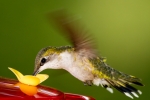 Flash |
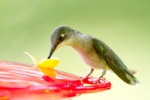 No Flash |
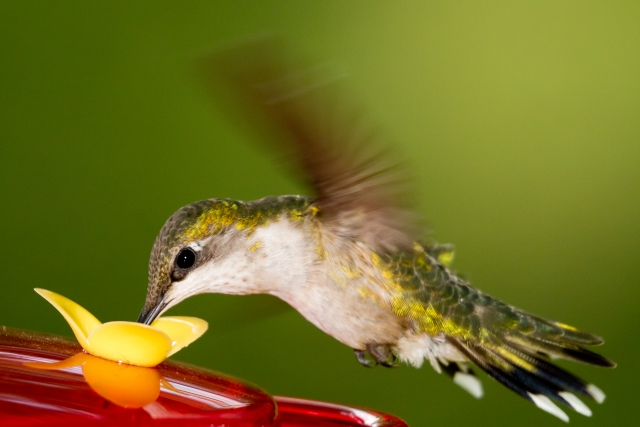 |
|
Technical Data: Canon EOS 7D, Canon EF 100-400mm f/4.5-5.6L IS USM (borrowed) at 400 with Kenko DG Auto Extension Tube (32mm), Flash: 1/1000 sec at f/5.6, ISO 800. No Flash: 1/250 sec at f5.6, ISO 1600. IS On. Canon Speedlight 580EX II flash in eTTL mode RAW conversion in Adobe Camera Raw.
I wish I could have had more similar images to compare, but I never managed to get a good shot of the hummingbird in flight without the flash (actually the flash would startle the hummingbird into flight and so most of those were of it in flight or just taking off). When using the flash, I am able to use high-speed-sync to get a high shutterspeed to freeze motion a bit more and also use a reduced ISO for less digital noise, but I feel it gives the image a bit more harsh look (that could potentially be mitigated with a diffuser that I might have to try next time). Without the flash, the image is given a much more natural look, but exposure becomes trickier. I do get more natural and calmer behavior from the bird without the flash, but with it does give that metallic reflection from the feathers...
So it is all about trade-offs, but which one do you prefer?
Thanks for stopping by!
- Bill
Two Birds with one Lens
ktuli — Tue, 07/22/2014 - 19:43
Well, so much for getting back to a more regular posting schedule...
I did manage to setup Tom's 100-400mm lens recently and got some decent bird photos. These are probably some of the best bird photos I've managed to date, so without any further ado I give you a pretty large bird and a fairly tiny bird, both shot with the same lens but in very different methods.
First up we have a Great Blue Heron (Ardea herodias) - we have these visit our pond with some regularity, but they still remain skittish and any attempt to approach them has proven difficult. This shot I managed from our front porch - I'd thought I used both a 2x and a 1.4x teleconverter on it, but the EXIF info is reporting only the 2x numbers, so I could be mistaken. One interesting thing here is that supposedly I shouldn't have been able to use autofocus for this shot, but I did. The Canon 7D (and most cameras) can only use autofocus is the maximum aperture value is larger than f/5.6. With this lens and any teleconverter, the effective maximum aperture is well above that mark (since the lens itself is f/5.6 and the teleconverters reduce that by 1, 2, or 3 stops if combined). However, putting the camera into live view and using the LCD to zoom in on my subject, I was then able to use AF without any issues at all. I'm sure the results aren't ideal - and that is evident if you look at this image at full size, but it certain had usable results here.
Technical Data: Canon EOS 7D, Canon EF 100-400mm f/4.5-5.6L IS USM (borrowed) at 400 with Canon EF 2x and 1.4x Telephoto Extender II, 1/640 sec at f/11. IS On. ISO 640. RAW conversion in Adobe Camera Raw.
This next one takes that same telephoto lens and uses it in a very different method. Instead of using teleconverters to extend its long distance capabilities, I instead used an extension tube to improve its close distance capabilities. I know the terms are confusing, but perhaps some day I'll write up the differences of teleconverters versus extension tubes, but for now just a quick explanation. Teleconverters are used to magnify the image, they usually come in 2x and 1.4x magnifications; their trade-off is that they reduce the amount of light coming into the camera and effectively make exposure more difficult. Extension Tubes are used to reduce the minimum focusing distance of a lens and by doing so provide a smaller degree of magnification; their trade-off is that they eliminate the lens' ability to focus on items farther away, but they do not affect the amount of light entering the camera.
Anyway, I used the Canon 100-400mm lens with a 32mm extension tube to allow for the lens to focus closer and provide a bit of magnification and pointed it at the hummingbird feeder on our porch. With patience, I managed to get a handful of shots using different methods - I'll share one today and a couple more soon.
Technical Data: Canon EOS 7D, Canon EF 100-400mm f/4.5-5.6L IS USM (borrowed) at 400 with Kenko DG Auto Extension Tube (32mm), 1/400 sec at f/5.6. IS On. ISO 1600. RAW conversion in Adobe Camera Raw.
As you can see, these are slowly improving. I'm happy to be able to start seeing the detail of individual feathers. I'll have to continue working on getting better results, but this is a nice step in the right direction.
- Bill

